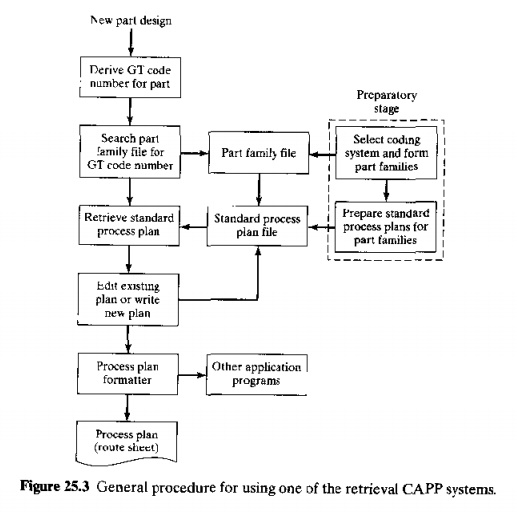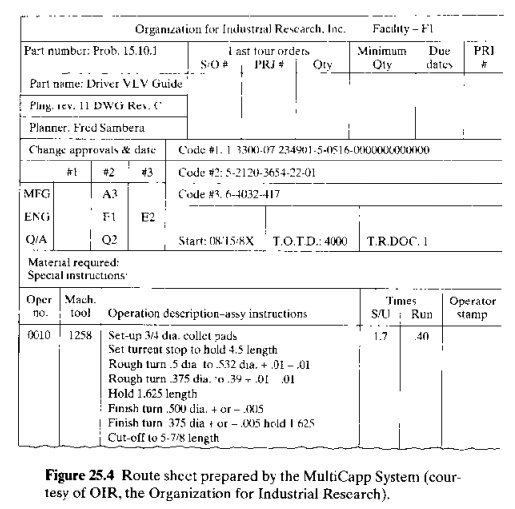Chapter: Automation, Production Systems, and Computer Integrated Manufacturing : Process Planning and Concurrent Engineering
Computer Aided Process Planning
COMPUTER AIDED
PROCESS PLANNING
There is
much interest by manufacturing firms in automating the task of process planning
using computer-aided process planning (CAPP) systems. The shop trained people
who are familiar with the details of machining and other processes are
gradually retiring, and these people will be unavailable in the future to do
process planning. An alternative way of accomplishing this function is needed,
and CAPP systems are providing this alternative.
CAPP is
usually considered to be part of computer-aided manufacturing (CAM). However,
this lends to imply that CAM is a standalone system. In fact, a synergy results
when CAM is combined with computer-aided design to create a CAD/CAM system. In
such a system, CAPP becomes the direct connection between design and
manufacturing. The benefits derived from computer -automated process planning
include the following:
Process
rationalization and standardization. Automated process planning leads
to more logical and consistent
process plans than when process planning is done completely manually. Standard
plans tend to result in lower manufacturing costs and higher product quality.
Increased
productivity of process planners. The systematic approach and the availability
of standard process plans in the data files permit more work to be accomplished
by the process planners.
Reduced
lead time for process planning. Process planners working with a
CAPP system can provide route sheets in a shorter lead time compared to manual
preparation.
Improved
legibility. Computer-prepared route sheets are neater and
easier to read than manually prepared
route sheets,
Incorporation o other application programs The CAPP
program can be interfaced With other
application programs, such as cost estimating and work standards.
Computer-aided
process planning systems are designed around two approaches. These approaches
are called: (1) retrieval CAPP systems and (2) generative CAPP systems. Some
CAPP systems combine the two approaches in what is known as semi-generative
CAPP.
Retrieval CAPP Systems
A retrieval CAPP system, also called a variant CAPP system, is based on the
principles of group technology (GT) and parts classification and coding
(Chapter 15), In this type of CAPP, a standard process plan (route sheet) is
stored in computer files for each part code number. The standard route sheets
are based on current part routings in use in the factory or on an ideal process
plan that has been prepared for each family. It should be noted that the
development of the data base of these process plans requires substantial
effort.
A
retrieval CAPP system operates as illustrated in Figure 25.3. Before the system
can be used for process planning, a significant amount of information must be
compiled and entered into the CAPP data files. This is what Chang et al., refer
to as the "preparatory phase:' It consists of the following steps: (1)
selecting an appropriate classification and coding scheme for the company, (2)
forming part families for the parts produced hy the company; and (3) preparing
standard process plans for the part families. It should be mentioned that steps
(2) and (3) continue as new parts are designed and added to the company's design
data base.

After the
preparatory phase has been completed, the system is ready for use, For a new
component for which the process plan is to be determined. the first step is to
derive the GT code number for the part. With this code number, a search is made
of the part family, file to determine if a standard route
sheet exists for/he given part code. If the file contains a process plan for
the part it is retrieved (hence. the word "retrieval" for this CAPP
system) and displayed for the user. The standard process plan is examined to
determine whether any modifications are necessary. It might be that although
the new part has the same code number. there are minor differences in the
processes required to make it. The user edits the standard plan accordingly.
This capacity to alter an existing process plan is what gives the retrieval
system its alternative name: variant CAPP system.
If the
file does not contain a standard process plan for the given code number, the
user may search the computer file for a similar or related code number for
which a standard route sheer does exist. Either by editing an existing process
plan, or by starting from scratch, the user prepares the route sheet for the
new part. This route sheet becomes the standard process plan for the new part
code number
The
process planning session concludes with the process plan formatter, which
prints alit the route sheet in the proper format. The formatter may call other
application programs into use: for example, to determine machining conditions
for the various machine tool operations in the sequence. to calculate standard
times (or the operations (e.g., for direct labor incentives). or to compute
cost estimates for the operations.
One of
the commercially available retrieval CAPP systems is MultiCapp, from OIR the
Organization for Industrial Research. It is an online computer system that
permits the user to create new plans. or retrieve and edit existing process
plans, as we have explained above. An example at a route sheet representing the
output from the MultiCapp system is shown in Figure 25.4.
Generative
CAPP Systems
Generative
CAPP systems represent an alternative approach to automated process planning.
Instead of retrieving and editing an existing plan contained in a computer data
base, a generative system creates the process plan based on logical procedures
similar to the procedures a human planner would use. In a fully generative CAPP
system, the process sequence is planned without human assistance and without a
set of predefined standard plans.
The
problem of designing a generative CAPP system is usually considered part of the
field of expert systems, a branch of artificial intelligence. An expert system is a computer program that
is capable of solving complex problems that normally require a human with years
of education and experience. Process planning fits within the scope of this
definition.
There are
several ingredients required in a fully generative process planning system.
First. the technical knowledge of manufacturing and the logic used by
successful process planners must be captured and coded into a computer program.
In an expert system applied to process planning, the knowledge and logic of the
human process planners is incorporated into a so called "knowledge
base."The generative CAPP system then uses that knowledge base to solve
process planning problems {i.e., create route sheets).
The
second ingredient in generative process planning is a computer-compatible description
of the part to be produced. This description contains all of the pertinent data
and information needed to plan the
process sequence, Two possible ways of providing this description are: (l) the
geometric model of the part that is developed on a CAD system dur10g product
design and (2) a GT code number of the part that defines the part features in significant
detail.

Figure
25.4 Route sheet prepared by the MultiCapp System (courtesy of OIR, the
Organization for Industrial Research).
The third
ingredient in a generative CAPP system is the capability to apply the process
knowledge and planning logic contained in the knowledge base to a given part
description. In other words, the CAPP system uses its knowledge base to solve a
specific problem-planning the process for a new part. This problem-solving
procedure is referred to as the "inference engine’ in the terminology of
expert systems. By using its knowledge base and inference engine, the CAPP
system synthesizes a new process plan from scratch for each new part it is
presented.
Related Topics